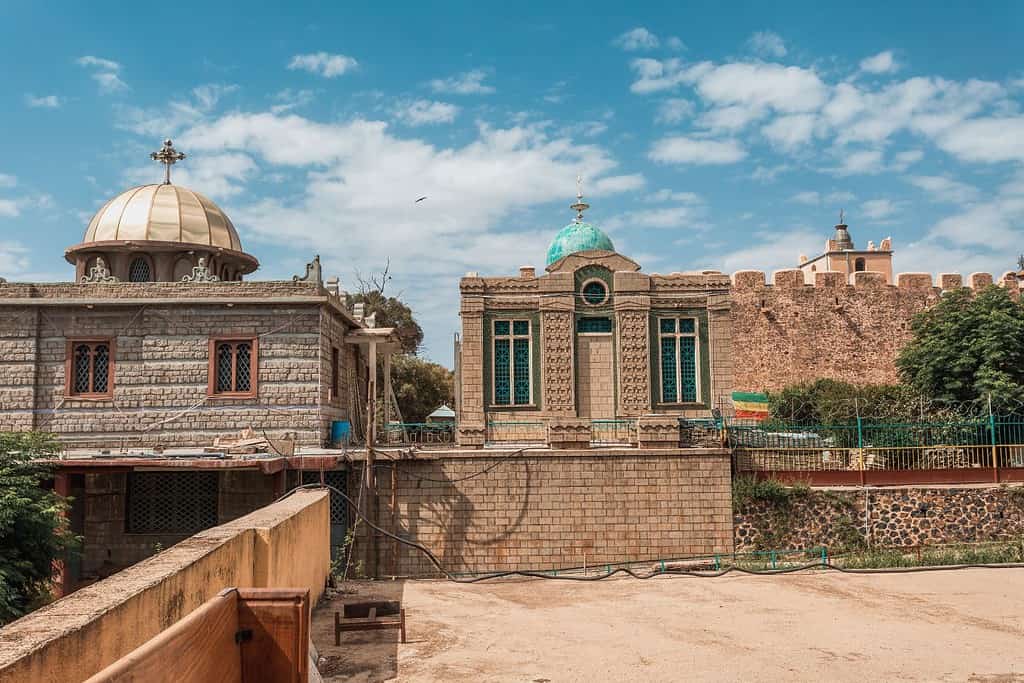Table of Contents
Where is Ethiopia located? Ethiopia is a country situated in the Horn of Africa, in the eastern part of the African continent. It is one of the largest countries in Africa.
Ethiopia is positioned in the northeastern region of Africa and shares borders with several neighboring countries. To the north, it is bordered by Eritrea. To the northeast, it shares a border with Djibouti and Somalia. To the east, it is bounded by Kenya. To the south, it shares borders with South Sudan and Sudan. To the west, it is bordered by South Sudan and Sudan as well.
Where is Ethiopia located: Africa.
Location of Ethiopia on the World Map
Ethiopia World
Map of Ethiopia.
Ethiopia Profile – Where is Ethiopia located
Here are 10 of the most important facts about Ethiopia:
- Official Name: Federal Democratic Republic of Ethiopia
- Capital City: Addis Ababa
- Population: Approximately 118 million (as of 2021)
- Official Language: Amharic
- Currency: Ethiopian Birr (ETB)
- Major Religion: Christianity (predominantly Ethiopian Orthodox Tewahedo Church, with a significant Muslim minority)
- Government: Federal parliamentary republic
- Area: Approximately 1,104,300 square kilometers
- GDP (Gross Domestic Product): $96.2 billion (as of 2021)
- Main Exports: Coffee, oilseeds, flowers, livestock, and textiles.

Borders of Ethiopia
Ethiopia shares land borders with six countries.
| Bordering Country | Approximate Length of Border (in kilometers) |
|---|---|
| Eritrea | 1,033 km |
| Djibouti | 342 km |
| Somalia | 1,600 km |
| Kenya | 861 km |
| South Sudan | 883 km |
| Sudan | 723 km |
Ethiopia Map
Navigate over this map with your mouse to discover Ethiopia’s map location.
Ethiopia
Most Extreme Points of Ethiopia
Ethiopia boasts several extreme points in various directions:
- Northernmost Point: Close to the border with Eritrea and Sudan, northeast of the town of Adigrat.
- Southernmost Point: The tripoint border with Kenya and South Sudan, near Lake Turkana.
- Easternmost Point: The point on the Somali border, east of the town of Danan.
- Westernmost Point: The point on the Sudanese border, west of the town of Kurmuk.
Highest Points of Ethiopia
The highest point in Ethiopia is Ras Dashen, reaching an elevation of approximately 4,550 meters above sea level. It is part of the Simien Mountains.
| No. | Mountain | Elevation (meters) |
|---|---|---|
| 1 | Ras Dashen | 4,550 |
| 2 | Mount Abuna Yosef | 4,379 |
| 3 | Mount Ras Dejen | 4,356 |
| 4 | Mount Bwahit | 4,430 |
| 5 | Mount Kidis Yared | 4,300 |
How big is Ethiopia?
Ethiopia spans an area of roughly 1,104,300 square kilometers, ranking as the 27th largest country globally.
Comparison with Neighboring Countries
Here is a comparison of Ethiopia with its neighboring countries based on approximate size and population as of 2021:
| Country | Approximate Size (sq. km) | Approximate Population | Ethiopia’s Size Compared to Neighboring Country | Ethiopia’s Population Compared to Neighboring Country |
|---|---|---|---|---|
| Eritrea | 117,600 | 3.5 million | 1.04 times bigger | 4.67 times smaller |
| Djibouti | 23,200 | 1 million | 5.24 times bigger | 11.5 times smaller |
| Somalia | 637,657 | 16.9 million | 0.17 times smaller | 2.63 times smaller |
| Kenya | 580,367 | 4 million | 0.19 times smaller | 0.46 times smaller |
| South Sudan | 619,745 | 11.4 million | 0.17 times smaller | 1.03 times smaller |
| Sudan | 1,861,484 | 44.9 million | 0.05 times smaller | 0.53 times smaller |
What to Visit in Ethiopia?
Ethiopia offers a rich tapestry of historical sites, diverse cultures, and stunning landscapes. Here are the top 11 tourist attractions:
- Lalibela: Also known as the “New Jerusalem,” Lalibela is a UNESCO World Heritage Site renowned for its rock-hewn churches, reminiscent of Petra’s architectural wonders.
- Axum: An ancient city and UNESCO World Heritage Site, Axum is famous for its obelisks, ancient tombs, and historical significance as a center of Ethiopian civilization.
- Addis Ababa: The capital and largest city of Ethiopia, Addis Ababa boasts a blend of modern skyscrapers, cultural landmarks, and bustling markets like the Mercato.
- Gondar: Known as the “Camelot of Africa,” Gondar features well-preserved castles, historic churches, and a rich imperial history.
- Bahir Dar: Located on the shores of Lake Tana, Bahir Dar offers access to ancient monasteries, beautiful Blue Nile Falls, and serene boat trips on Lake Tana.
- Simien Mountains: A rugged and stunning mountain range known for its breathtaking scenery, hiking trails, and unique wildlife, including the Ethiopian wolf.
- Harar: A historic city in eastern Ethiopia, Harar is known for its ancient walled city, colorful markets, and unique culture, including the tradition of feeding wild hyenas.
- Awasa: A picturesque city in the Great Rift Valley, Awasa is famous for its scenic lakeside views, birdwatching opportunities, and vibrant local markets.
- Jijiga: Located in the Somali Region, Jijiga offers a distinctive cultural experience, with its unique architecture, traditional markets, and a glimpse into the diverse cultures of eastern Ethiopia.
- Dire Dawa: A vibrant city in the eastern part of the country, Dire Dawa is known for its cultural diversity, bustling markets, and the charming Kefira Market.
- Adama: A city in the Rift Valley, Adama offers a relaxing atmosphere, hot springs, and easy access to the stunning landscapes of the surrounding region.
These Ethiopia destinations offer a diverse array of experiences, ranging from delving into ancient history and religious significance to savoring the vibrancy of modern city life and immersing oneself in the breathtaking natural beauty of Ethiopia’s landscapes. Please be aware that certain locations, particularly religious sites like Lalibela and Aksum, may have specific restrictions or entry requirements. Therefore, it is crucial to conduct thorough research before organizing your visit.
More About Ethiopia
[the-post-grid id=”50355″ title=”Ethiopia Main page”]
